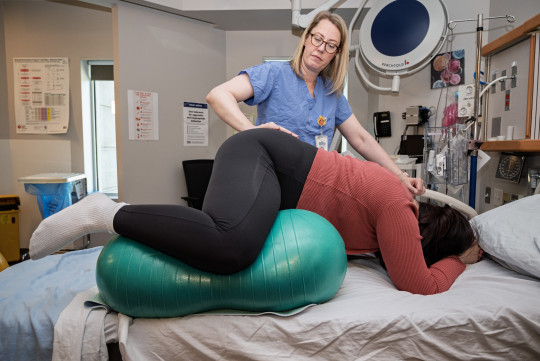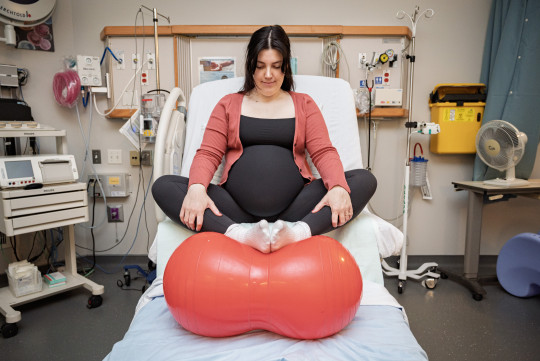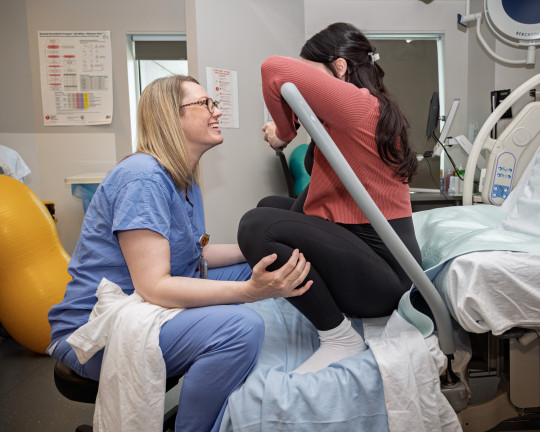An initiative in the IWK birth unit is showing significant promise in lowering the number of unplanned Caesarean sections (CS) at the hospital. The Full Moon Challenge promotes a strategy for birthing person positioning during labour. Within the three months of its implementation unplanned CS dropped from 24 percent to 16 percent.
During the challenge nurses were asked to adopt an evidence-based strategy for positioning in labour. The ‘Full Moon’ is a circuit of 4-point position changes done at 20-to-45-minute intervals. These positions would include having the pregnant person lie on their left side, sit in an upright position, lie on their right side and sit or kneel leaning forward.
“The sequence and frequency of position changes in labour, guided by the Full Moon Challenge, helps promote shorter labours, less pain, and more spontaneous vaginal births,” says Jennifer Jollymore, Clinical Nurse Specialist, IWK Birth Unit. “Movement in labour promotes natural and instinctive body motion, helps reduce pain, and can involve partners and support persons in the labour process.”
There are around 4500 births each year at the IWK. Before the challenge about 30 percent of babies were born by CS. In the months during the Full Moon Challenge the unplanned CS rate showed a marked improvement in the IWK Birth Unit starting at 24 per cent and falling to 22 percent in the first month, 18 percent in the second month and then 16 percent in the challenge’s final month.
“I’ve witnessed the effectiveness of the Full Moon Circuit on baby’s position in the pelvis and how that helps labor along,” says Hannah Hudson, a labour and delivery nurse, and new mother. “Now having experienced this firsthand for myself I have a new appreciation for the circuit, and for the work it takes to help prepare yourself and baby for labor and birth.”

“Repositioning and movement in labour is something our staff have been taught and practice regularly,” says Dawn Murphy, RN Staff Nurse, IWK Birth Unit. “The Full Moon project further supports this by providing a simple but sequential or circular path of movement that even less experienced care providers can build into their practice. And staff benefit from seeing their knowledge and hard work in action.”
“I am grateful to say my labor was fairly quick and smooth for my first time giving birth,” says Hudson. “I believe I can attribute that to a prepared cervix and well positioned baby, with so much help from the Full Moon Circuit.”
The researchers are now looking at creating a Full Moon Challenge Toolkit that would support provincial and national colleagues with implementing the Full Moon Challenge in their hospitals so they can lower the unplanned CS rate in their birthing units.
“I think one of the strongest features of this initiative is that it's nurse-driven,” says Murphy. “All staff and support persons involved in the birthing person's care can utilize The Full Moon strategy, but it began with nurses, it's implemented and supported mainly by nurses, and it is being evaluated and promoted by nurses. I feel that the initiative is a beautiful example of how nursing care and research has the potential to positively impact healthcare in a big way.”

IWK Nurses Patti VanRitchie and Taylor Kavanaugh have developed and run their own class to teach healthcare providers about optimizing fetal positioning in labour.
“We are all working towards changing hospital birthing care culture and one of the initial steps in the process is providing education,” says Jollymore. “Patti and Taylor have been actively working on that and the education continues.”
“An emergency or unplanned CS can also be stressful for the birthing team, especially when it’s already very busy on the unit,” says Jollymore. “Shorter labour times and reduced CS rates put less stress on the finances and staffing of the health care system in general.”
Caesarean sections are one of the most commonly performed surgeries in Canada, representing a significant cost to the healthcare system and the long-term health of birthing people and their families.
